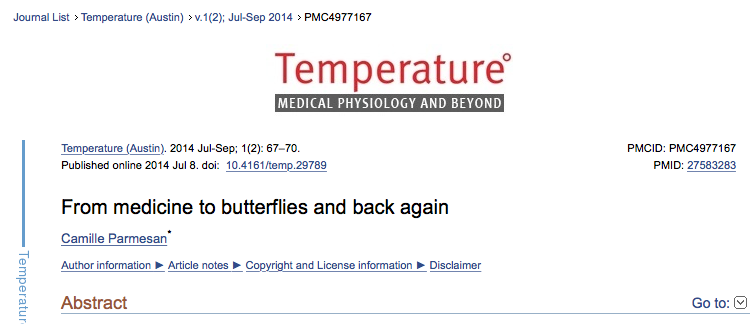
Exhibit A, screenshot The Guardian. Going political -payed by a politician- without first allowing other scientists to replicate your work, where the data do not support your claims
As the Lancet noted in April 2015 a replication-crisis in science suggests that at least 50 percent of papers that appear in ‘peer reviewed’ journals may simply be untrue.
For the environmental sciences, this rate may be even higher as Peter Kareiva and Michel Marvier noted in their article Uncomfortable questions and inconvenient data in conservation science’ in ‘Effective Conservation Science, Data not Dogma, (Oxford University Press 2018)

I hope Camille will enjoy my little joke
Peer review is failing, and thus it is not the pivot of scientific accuracy as it is sold to the public. I here present some cases of pal review’, with less scrutiny if the ‘results’ sound spectacular or fit in a popular narrative that advances agendas.
Also ‘null results’ tend not to be published, and studies debunking ‘hyped’ articles tend to be ignored by popular media. The same practice has also been noted by fisheries scientist Ray Hilborn in his paper ‘Faith Based Fisheries’ (2006) on papers in major journals (Nature and Science) advocating marine reserves.

Nature 1996, the letter to the editor on Ediths Checkerspot butterfly that launched Parmesan into the Climate Establishment
Habitat improvement, not ‘climate change’ influenced Checkerspot distributions
In this article we will treat A prime example of this replication crisis. The urgency of this crisis is also advocated by the Netherlands Research Integrity Network, and the World Conference on Research Integrity Foundation.
This failure of replication was discovered and described in 2013 by ecologist and conservationist Jim Steele of San Francisco State University, and former director of the SFSU-field campus in the Sierra Nevada. To this day his request to Parmesan to hand over data is ignored.
He maintains the website Landscapes and Cycles.net (after the book in 2013), and describes his ‘journey’ from conservation to climate skepticism. His ‘Saulus-Saint Paul’-moment to ‘climate skepticism’ was the work of Parmesan that was based on data on the Edith’s Checkerspot Butterfly collected in Steele’s own conservation-area, in the Sierra Nevada.
That Parmesan-paper we will return to shortly. First we give a shorthand discussion of Steele’s conservation work.
Steele had worked as a conservationist in the area, in order to restore bird- an butterfly-habitat in the Sierra Nevada. In his book he describes how he- in the function of field campus-director- was asked by local authorities to find out why various bird populations had disappeared.
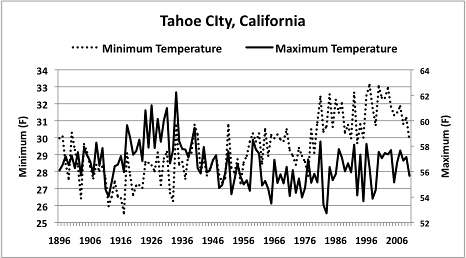
Local Maximum temperatures decreased while minimum temperatures increased
Steele checked all factors from hydrology to local climate and temperature trends.
He then pe learned from the temperature records of Tahoe city in California that ‘local maximum temperature had decreased significantly since the 1930’s. So, while ‘global average temperature’ has risen, the temperatures that should imply heat stress to local populations showed a reverse trend.
As Steele writes in his 2013-book:
Although I doubt that temperature trends in a tourist town like Tahoe City accurately represented the micro-climate of our wilderness meadows, most USHCN weather stations throughout the Sierra Nevada indicated that the climate envelope was converging towards a temperature optimum by lessening both heat and cold stress. (his emphasis added RZ)
After eliminating all other possible factors, It turned out that a century-old dam had drained the area of water, making vegetation more prone to drought by summer maximum-temperatures.
After removing the dam, the hydrology of the area improved, vegetation restored and bird populations restored their former ranges. A prime example of effective local conservation success. In his book, Steele now argues that the globalist focus of climate has hijacked the conservation agenda, to the detriment of effective conservation.
I support this view, because it can be seen in The Netherlands as well.
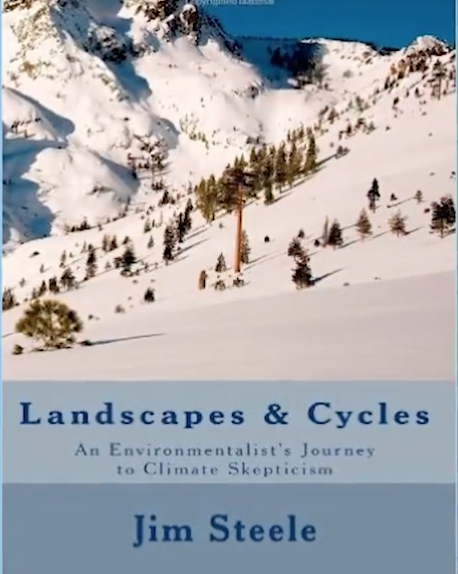
The book of this day’s article
A localized distribution turned into ‘global’ problem
Steele’s prime example of conservation success, (land-use changes drive population changes in the Sierra Nevada), was however turned into ‘the fingerprint of global warming’-story by Camille Parmesan from 1996 onwards as Steele was to find out..
Camille Parmesan her authority in the climate-biology-community was founded on her ‘letter to the editor’ in 1996: Climate and Species Range. Based on distribution data of the Edith’s Checkerspot butterfly in the Californian Sierra Nevada, Parmesan suggested a northward distribution of 100 km caused by CO2-induced ‘Climate Change’, meaning global average temperature, not local micro-climates.
The letter was published at the invitation of the editors of the prestigious journal. In these ‘letters to the editor’ the author is not obliged to hand over their data for others to replicate the findings.
While the findings were never replicated, as of this year, this paper is cited 846 times, and about 500 times when Steele wrote his book (2013). At a first glance, the work seemed impressive, based on 4 years of field work.

Cited by 864, replicated by none…
The study was immediately seized upon by popular media like The New Scientist,stating ‘Edith’s Butterfly Flees North’.
The ‘fingerprint’ of global warming was claimed to be found. A result that seemed all to welcome by the IPCC-establishment around climate scientist James Hansen (NASA), who had advocated research confirming this ‘fingerprint’ in species distribution.

…among many others, however, there were no northern shifted populations to be found, as her husband Michael Singer admits
As if ‘average global temperature’ – a statistical artifact that does not exist in the real world- would be the sole predictor of species distribution. And not the local climate that is dependent on land use changes, humidity, food availability etc.
Every field biologist knows that no plant or animal has ever lived it’s life in ‘global average temperature’, in statistical artifacts- chimera’s- that do not really exist.
Local micro-climates are a determinant of species distributions, depending on multiple factors apart from the averaged air temperature. All adaptation of real world species is LOCAL, not globally averaged.
Parmesan is/was married to Checkerspot-expert Michael Singer of the University of Texas and was his research assistant at the time of research in the early nineties.
An other collaborator was the British biologist Chris Thomas, who’s career was also catapulted by ‘global average temperature’. We therefore first treat Thomas his catapult-paper as example, because it was also hyped by the IPCC in it’s fourth assessment report.

Eiders at Helgoland. The arctic ducks shifted their range SOUTH-wards, like various other arctic species (pe Fulmar, Brent geese, merganser)
Global Average Temperature drives academic careers to higher altitudes
The latter – Chris Thomas- became famous with his claim in the most cited climate change-study in modern academic history, published in Nature in 2004: Extinction Risk from Climate Change, predicting 15-37% of ‘species’ would be ‘committed to extinction’ from 2050 onwards.
This paper has been cited over 6000 times, without having the slightest relation to real world data on existing species. The study cannot be replicated with real world data, because it is a model-artifact that claims to predict the future.
The Thomas-study was also hyped by mainstream-media stating that ‘a million species’ were committed to extinction. This figure of ‘a million’ was calculated as 1/3 (the average of extinction predictions) of a theoretical 3 million species living on earth (with app 1.8 million currently described by science).
This ‘million species’ claim was promoted by Thomas and others from the Climate Biology-establishment as Lee Hannah.
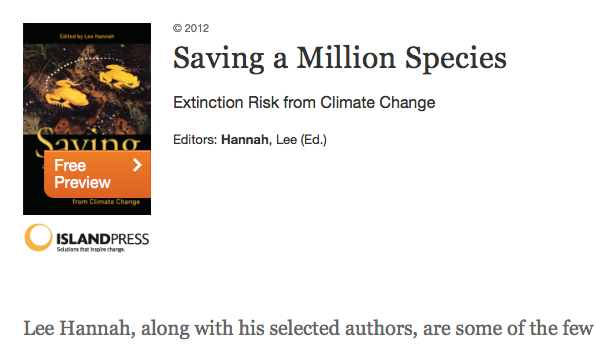
‘Global Average Temperature’, media-alarmism, and virtual species in Species Area Relationships advance academic careers
These ‘extinctions’ were based on Species Area Relationships (Preston 1962) with a z-value of 0,25: this means that Thomas et al assumed that ‘climate warming’ would be equally devastating as pe deforestation of other habitat destruction.
The assumption is then in the used Species Area Relationship, that a reduction of suitable ‘climate living space’ of 90 percent, would commit 50 percent of ‘species’ (theoretical entities) to ‘extinction’. Which means: non-existent species gone in virtual reality.
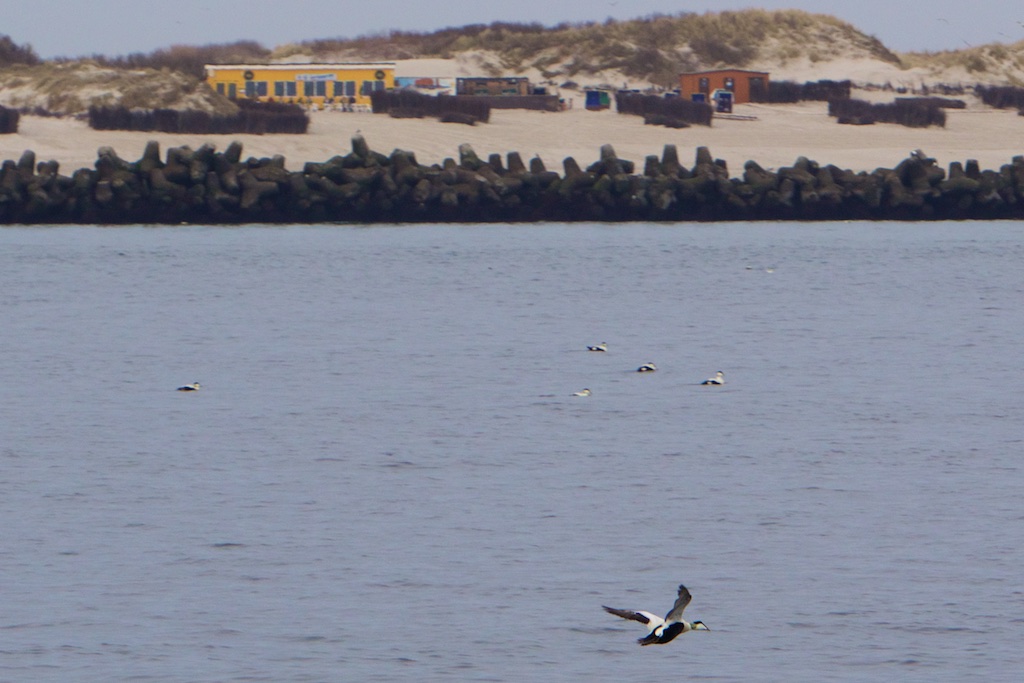
Eiders Ducks at Helgoland. The arctic species – together with dozens of others- shifted range southwards in ‘the age of global warming’ as opportunistic feeder on bivalves
Observations on breeding birds in NW Europe example contradict the basic assumption from these climate-envelope-logic of ‘species fleeing north’. For example, the Netherlands have warmed more than the global average.
Nevertheless, more ‘northern’ bird-species have established as breeders in the Netherlands in the last century – pe like the arctic eider duck, brent geese and the merganser- then ‘southern’ birdspecies have moved northwards.
Finding the possibility to exploit new territory and food sources seem a probable explanation for bivalve-feeders, that profited from eutrophication and therefore shellfish-abundance. This opportunism is also found with the Fulmar, an arctic bird that exploits the discards of fisheries.
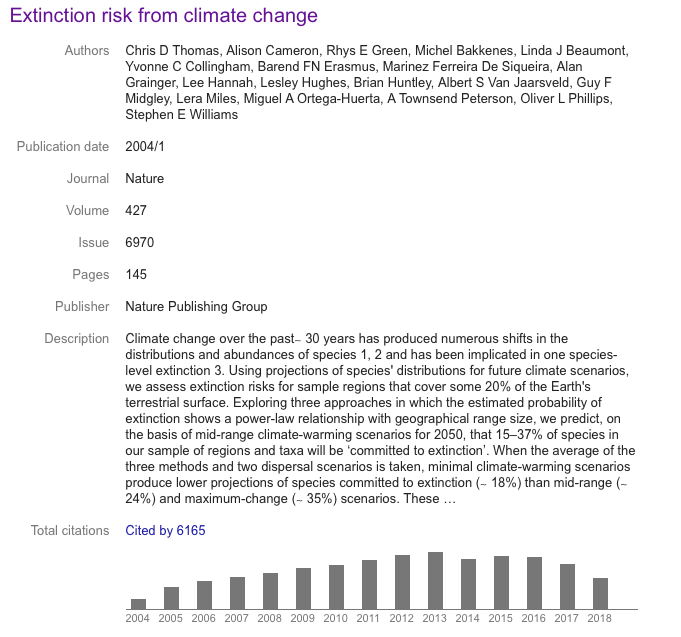
The prime example of ‘average global temperature’ driving theoretical species to ‘extinction’, from Christ Thomas, a collaborator of Singer and Parmesan,
Apart from the flawed logic of species following ‘global average temperature’, the over-representation of endemics (earlier prone to extinction) and virtual reality, also the used SAR-method is inclined to overstate theoretical extinction risks.
It has therefore already been ‘debunked’ by pe ecologist Stephen Hubble in Nature (2011), stating that the used method with the used Z-value (0,25) overstates extinction by up to 160%. In this case, the scientific process seems to have worked, alas, after the political effect was used to benefit various careers.
The Lead Author-moment of Parmesan
Parmesan was invited shortly after her claim to climate fame in 1996 to the White House (Clinton Administration), as she writes in 2014 in ‘Temperature’. The 1996 publication was her ‘reinvention as a field biologist’, the Saulus-Saint Paul-moment.

… The Saulus-Paulus-moment of Parmesan….
The letter to the editor catapulted Parmesan her career as IPCC lead author as she writes:

Average Global Temperature drives many academic careers to higher altitudes
Parmesan is one of popular media’s favorites in promoting climate alarmism. She was quoted in 2010 in ‘Science Watch’ stating:
it was a bloody obvious change. These butterflies were shifting their entire range of the past century northward and upward, which is the simplest possible link you could have with warming. I was expecting some incredibly subtle, sophisticated response to warming, if at all.
What I got was 80 % of the populations in Mexico and the Southern California populations were extinct, even though the habitats still looked perfectly fine.
…
Parmesan refuses to hand over data
However, as Steele notes: these populations were not extinct.
The Sierra Nevada-population is a so-called Meta-Population, of interconnected localized populations. Depending on local micro-climatic conditions- like humidity and higher temperatures – BENEFITING the butterfly’s survival in the mountainous area, some local populations disappear and re-appear on a yearly basis.
Parmesan’s conclusions thus were based on snapshots of absent populations in time, that later recovered.
As of 2013 Jim Steele writes that he asked Parmesan (by phone and e-mail) to hand over the data-sets on which populations she had researched. To this day Parmesan refuses this, and her husband Michael Singer later replied (pg 25):
Her study DID NOT FIND NEW NORTHERN, or higher population of the species…. There are no ‘new’ northern populatons known from past records and assessing which of them was currently extant or extinct. No ‘new’ populations were sought or found’.

I hope Camille and her close friend the French President will enjoy my little joke
Conclusion: Parmesan knows she is a fraud
Nevertheless, after being requested to hand over data, and after the refusal, and after the confirmation of her husband that no northward shifts were found, in 2014 Parmesan still cites this unreviewed work as her ‘Reinvention as a field-biologist’-moment.
Also Singer knows that HE is a fraud. Because, as Steele cites Parmesan clearly that she claims ‘bloody obvious’ northward shifts in popular media. And in the 1996-letter to the editor it is Parmesan herself who- in collaboration with Singer- states:
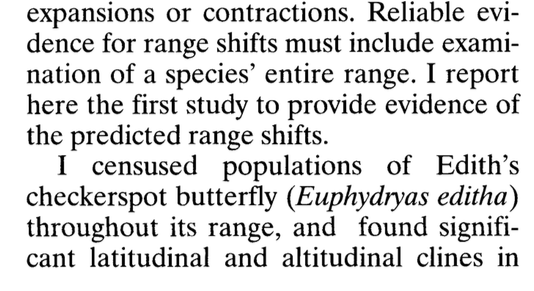
..
‘I report here the first study to provide evidence of the predicted range shifts’.
A shift must include northwards distribution which was not found in the Sierra Nevada-data. Also no populations were permanently extinct. Apparently Michael Singer resorted to arrogance, treating Jim Steele as a junior degree.

Parmesan would be on our list of ‘to be re-reviewed’
1 percent of science-budget to review peer-review
Unfortunately, in the current scientific arena, the critics are the ones that are persecuted by their universities. It is to no surprise that Parmesan collaborates with the ‘coral alarmist’ Oeve Hoegh-Gouldberg, who advocates the demise of pe the Great Barrier Reef by Global Warming.
Hoegh Gouldberg is also the most powerfull media-voice in Australia and a gate-keeper of coral science at major journals.
Meanwhile several other ecologists have noted, that the reef is in healthy condition, and that alarmist claims are not backed up by sound evidence and data.
However, a billion-(Aussie)-dollar scheme for it’s ‘protection’ is now launched based on the Hoegh-Gouldberg premises. And now the scientist Peter Ridd is ousted from academia, being found guilty by pointing to failures in the scientific process leading to alarmist conclusions.
Even the secular globalist advocacy-‘journalists’ of the Rockefeller Foundation-funded The Guardian, agree on the issue of Peter Ridd, regarding academic freedom to dissent.

‘minority views’, sacking academics for dissent
So needless to say, we live in Interesting Times ( = ‘Interessante Tijden’ in Dutch) if ‘majority’ dictates ‘truth’ in science.
If ‘majority’ views evolved from minority into majority by neglecting basic scientific standards (replication) your flawed science may become the majority. But it will never be more ‘true’.
Powerful friends apparently dictate more what the truth is in current environmental sciences and how your career is catapulted. Camille Parmesan her funding from Macron, the president of France suggests that you are regarded a ‘good scientist’ if you advance the agenda of globalist bankers (2030 Agenda) and their political pets.

The Author asks for your support 🙂
Support my work
Unlike the Guardian- who receives millions of dollars from the Rockefeller Foundation, my science journalism and photography is solely sponsored by readers like you.
I do not need a large SUV or a multiple digit bank-account, but need funding for the three basic necessities that help me on the road and help you to be an informed citizen: Beer (10 euro), Books (25 euro) and Gasoline (100 euro)
Donations can be made to SMW&B Foundation in Delft (The Netherlands). IBAN NL04INGB 0005526038 under the name of ‘Interesting Times’. Donations are tax deductible. We of the alternative media can make the difference.
